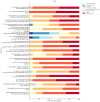Integrating Telemedicine in Botulinum Toxin Type-A Treatment for Spasticity Management: Perspectives and Challenges from Italian Healthcare Professionals
- PMID: 39728787
- PMCID: PMC11679457
- DOI: 10.3390/toxins16120529
Integrating Telemedicine in Botulinum Toxin Type-A Treatment for Spasticity Management: Perspectives and Challenges from Italian Healthcare Professionals
Abstract
(1) Background: Telemedicine is a vital tool for enhancing healthcare accessibility and outcomes at reduced costs. This study aimed to assess the usability of the Maia Connected Care telemedicine platform for managing spasticity in patients receiving botulinum toxin type-A, focusing on the perspectives of Italian physiatrists with expertise in this treatment. (2) Methods: Conducted from March 2023 to June 2023, this multicenter survey involved 15 Italian physicians who used the platform for teleconsultations. Data collected included demographic details, responses to the Telemedicine Usability Questionnaire, and physician insights on patient satisfaction, treatment effectiveness, and implementation challenges in telehealth. (3) Results: The platform demonstrated high usability, with strong physician satisfaction due to its user-friendly interface and quality of interactions. A majority expressed willingness to continue telehealth for spasticity management, noting its effectiveness in improving patient satisfaction and outcomes. Challenges included replicating the depth of in-person consultations and addressing issues like reimbursement and telehealth standardization. (4) Conclusions: This study highlights telemedicine's potential for spasticity management and clinician satisfaction, while underscoring the need for improvements in simulating in-person experiences and addressing systemic issues. The absence of patient perspectives represents a limitation, advocating for future research to optimize telemedicine practices and evaluate long-term clinical impacts.
Keywords: botulinum toxin Type-A; hybrid care model; spasticity; telemedicine; usability.
Conflict of interest statement
The authors declare no conflicts of interest.
Figures
Similar articles
-
Satisfaction with botulinum toxin treatment in post-stroke spasticity: results from two cross-sectional surveys (patients and physicians).J Med Econ. 2014 Sep;17(9):618-25. doi: 10.3111/13696998.2014.925462. Epub 2014 Jun 12. J Med Econ. 2014. PMID: 24841450
-
The Italian real-life post-stroke spasticity survey: unmet needs in the management of spasticity with botulinum toxin type A.Funct Neurol. 2017 Apr/Jun;32(2):89-96. doi: 10.11138/fneur/2017.32.2.089. Funct Neurol. 2017. PMID: 28676142 Free PMC article.
-
Management of stroke patients submitted to botulinum toxin type A therapy: a Delphi survey of an Italian expert panel of specialist injectors.Eur J Phys Rehabil Med. 2014 Oct;50(5):525-33. Epub 2014 Jun 19. Eur J Phys Rehabil Med. 2014. PMID: 24963604
-
Adjuvant treatments associated with botulinum toxin injection for managing spasticity: An overview of the literature.Ann Phys Rehabil Med. 2019 Jul;62(4):291-296. doi: 10.1016/j.rehab.2018.08.004. Epub 2018 Sep 13. Ann Phys Rehabil Med. 2019. PMID: 30219307 Review.
-
[Botulinum toxin in spasticity treatment].Neurol Neurochir Pol. 1998;32 Suppl 1:71-84. Neurol Neurochir Pol. 1998. PMID: 9608556 Review. Polish.
Cited by
-
Optimizing Recovery: An Opportunity to Improve Access to Post-stroke Rehabilitation Care in Rural Settings.Cureus. 2025 Jun 13;17(6):e85939. doi: 10.7759/cureus.85939. eCollection 2025 Jun. Cureus. 2025. PMID: 40656392 Free PMC article.
-
Barriers to Long-Term Adherence in Botulinum Toxin Therapy for Post-Stroke Spasticity: Insights and Implications from a Single-Center Study in North Italy.Toxins (Basel). 2025 Feb 22;17(3):102. doi: 10.3390/toxins17030102. Toxins (Basel). 2025. PMID: 40137875 Free PMC article.
References
-
- Mariani M.V., Pierucci N., Forleo G.B., Schiavone M., Bernardini A., Gasperetti A., Mitacchione G., Mei M., Giunta G., Piro A., et al. The Feasibility, Effectiveness and Acceptance of Virtual Visits as Compared to In-Person Visits among Clinical Electrophysiology Patients during the COVID-19 Pandemic. J. Clin. Med. 2023;12:620. doi: 10.3390/jcm12020620. - DOI - PMC - PubMed
Publication types
MeSH terms
Substances
LinkOut - more resources
Full Text Sources
Medical



